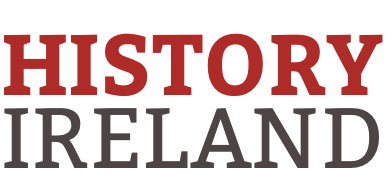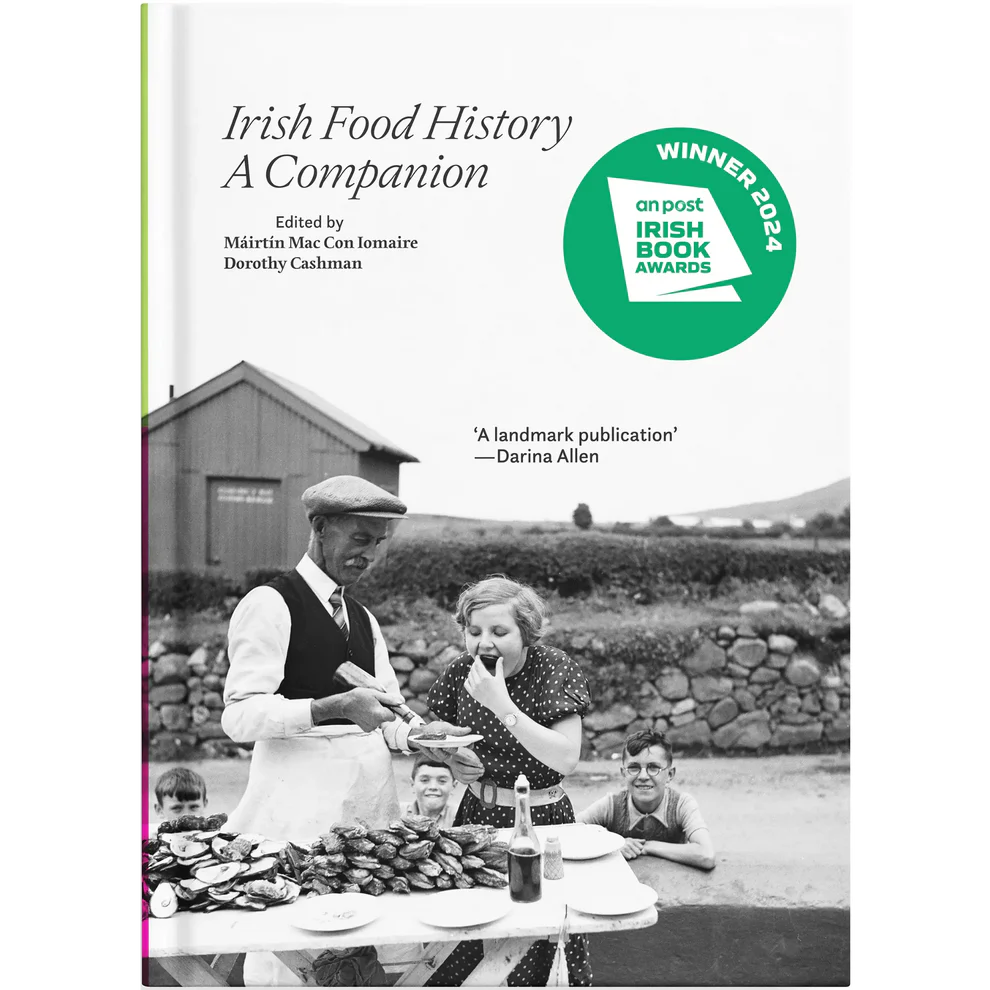MÁRTÍN MAC CON IOMAIRE and DOROTHY CASHMAN (eds)
Royal Irish Academy in collaboration with EUt+ Academic Press
€45
ISBN 9781900454827
REVIEWED BY
Claire Connolly
In 1969 two French food critics penned a guidebook—the Guide Juillard de l’Irlande—in which they shared some good news. Things were getting better in Irish kitchens. The sting in the tail, though, came in their remark that ‘the tragedy of Irish cuisine is not that it is bad but that the Irish believe it is very good’. Ouch! The Irish relationship with food has not always been easy, taking in episodes of dire scarcity that gave way all too easily to periods of boosterism and boasts about Michelin stars. In between these poles are the ordinary Irish people, who have always had to eat and cook food and who have suffered terribly during times of shortage.
The story of the French reviewers is found, along with a host of other good things, in Irish food history: a companion, edited by Mártín Mac Con Iomaire and Dorothy Cashman. It’s a big book, containing 28 chapters that range from prehistory to the present, covering agricultural practices, food products, material culture, cooking, preserving, pubs and place-names, not to mention famine, starvation and bad harvests. Readers can feast on stories of butter, fish, honey, oats, potatoes, whiskey and seaweed while also wondering at the presence of almonds, curries, grapes, spices and oranges on Irish tables. Meanwhile, mysteries remain: did our ancestors bury butter in the bog in order to add flavour, to mark territory, to guard against lean times or to safeguard and refrigerate a precious substance? Recent genetic research adds to scientific understanding of a product made from the milk of cows, sheep and goats but does not settle on a single understanding of the history of what Maeve Sikora and Isabella Mulhall describe as ‘one of the most enigmatic of all known archaeological finds’.
We find more certainty as the centuries progress. Different grades of butter (along with honey and wheat) were given to élite children in medieval Ireland according to their rank, as Shane Lehane explains in his chapter on bee-keeping. Claudia Kinmonth takes the reader on a detailed, expert tour through all the steps of the butter-making process, starting with byres, sheds and dairies, taking in churns, firkins and trenchers, and moving through scoops, skimmers, spades, knives and spreaders.
As the book moves on to early modern Ireland, an expanded range of sources becomes available while a focus on food consumption as well as production comes more emphatically into view. Restaurants or eating-houses, though, form only a small part of the story. The places in which food was prepared and consumed in Ireland include cabins, grocers’ shops and big houses, continuing up to carveries and hotels. Coming near the end of the book, Margaret Connolly’s chapter on Myrtle Allen brings us up to the restaurants that are now a familiar part of Irish food culture, even if many of them serve green beans from Kenya and asparagus from Peru in the place of the indigenous ingredients advanced by ‘the matriarch of modern Irish cooking’ with her ‘radical food philosophy’. Typical take-away foods—the spice bag (recently added to the Oxford English Dictionary), the breakfast roll, the sugary shop pastry that congeals around the teeth of Marianne in Sally Rooney’s Normal people—are an omission from the book, as are the changes wrought by migrants to Irish food history as it continues to evolve.
For private homes, surviving recipe books help to fill out the picture of past eating patterns. Danielle Clarke reads recipes as contested, colonial documents, testaments to the lives and experiences of Anglo-Irish families whose property originated in dispossession. In the case of the Parsons family of Birr Castle, recipes are found alongside material relating to medical care, agricultural improvements and household management. One finding from this book is that exotic items have always found their way onto Irish tables, though Toby Barnard’s chapter on ‘Food in Eighteenth-Century Ireland’ points out that even the most dedicated improvers could not make sugar or tea flourish in Irish soil. The taste that grew up for tea and white bread soon descended to the lower orders and remained associated with poverty and poor nutrition well into the period of the founding of the new Irish state. Ian Miller’s chapter on ‘Hunger and Starvation in Modern Ireland’ not only tells some tough truths about impoverished diets in pre- and post-independence Ireland but also addresses contemporary food poverty and the poor health outcomes that follow ‘budgeting and dietary decisions which demand complex understandings and interventions’.
There have long been efforts to educate and inform the Irish public about making better food choices. Dorothy Cashman, one of the book’s editors, considers Irish cookbooks and domestic science manuals from the late nineteenth century onwards, finding that such publications flourished even as women’s public roles began to dwindle around 1914. Drawing on research by Joanna Bourke and Ciara Breathneach, Cashman shows how a downward curve in women’s employment was matched by an upward trend in the commissioning and publication of guides to domestic economy. Cashman is clear-eyed about the lives of Irish housewives but is most interested in the professional women who were employed (by co-operatives, convents, technical schools and the Department of Trade and Industry) to instruct those stuck at home.
Cashman doggedly tracks down the career of one Marion Laird (1872–1954), a sometime instructress at the Munster Institute in Cork who insisted on payment for a collection of recipes that she authored on behalf of the Department of Agriculture and was rewarded by having her name removed from the book. When a department official named Mr Coyle asked Ms Laird to provide the Irish translation for the classic French beef stew pot-au-feu along with a recipe for the same, she wrote back to say that she could not provide the former and nor would she recommend the inclusion of the latter: ‘we must be even more economical than the French and keep the soup until the next day’. She also insisted on retaining the spelling ‘Barm Brack’ for the traditional Irish yeast bread made with sultanas and raisins—Mr Coyle regarded ‘Barn Brack’ as authentic and the former a ‘beastly Saxon corruption’—but compromised by including his recipe for Apple Charlotte in a revised edition of her book.
Mártín Mac Con Iomaire and Dónall Ó Braonáin’s chapter, ‘Seventy-Two Words for Potato’ comes a little over halfway through the book, as befits the central role of the potato in the Irish food story. Without potatoes, Ireland would not have seen the population growth that made the country such a wonder to political economists. And without the potato blight we would not have seen the horrific falling away of the Irish population in the Famine years. But food words tell their own story, one bound up with place, produce, crops and animals, explored in this chapter across a dazzling array of examples. Mac Con Iomaire and Ó Braonáin offer nothing less than a master-class in food history, drawing on foundational work by Regina Sexton and others as they chart linguistic changes and lay out methodologies for others to follow.
What are our sources for Irish food history? Contributors to the book have looked for the history of Irish food in the land itself, as well as in material kitchen objects, cookbooks, recipe manuals, letters and folklore. Seamus Caulfield’s magical account of the Céide Fields connects his own childhood experiences to the story of the first farmers who brought cattle and cereal to Ireland. The pages of Irish fiction might have been further prospected for evidence: novels by Maria Edgeworth and Lady Morgan all feature key scenes that turn on foodstuffs, while their letters routinely note dishes consumed and recipes gleaned or coaxed from friends. In Edgeworth’s The absentee (1812)—briefly referenced in Toby Barnard’s chapter for its mention of the sugared Irish plum—the ostentatious Mrs Raffarty serves hare in a wine sauce and sea kale along with macaroni and puddings moulded in pyramids. The wine sauce splits, the puddings topple over, and the dinner is described in terms of ‘profusion and pretension’.
And yet some years later, in 1831, Edgeworth wrote to her stepmother from London, enthusing about a sea kale salad dressed with a lot of oil and a little vinegar, a dish that has ‘the double advantage’ of tasting ‘as if lobster was in it’ while also giving new interest to the vegetable just as asparagus harvest comes in and starts ‘shoving’ sea kale ‘from the table’. Beetroot might be added, Edgeworth concluded, expecting that her stepmother ‘should bless me all the remainder of your life or at least of mine for this salad—provided always that you have never heard of it before which much it fears me you have. Pray say.’
Just such an open-textured flow of food information, thoughts and opinions resonates across many of the chapters in the book. Grace Neville’s chapter on Daniel O’Connell draws on correspondence between the Liberator and his wife to make a case for food as a ‘parallel language’, conveying ambition, appetite, comfort and care. O’Connell shared with his wife details of London dinners (‘turtle—turbot, champagne etc’) while also reassuring her that he was taking plenty of fast-paced walks through the city: ‘Yet I get fat. I ought not, I believe, to eat so much.’ Neville’s chapter is a reminder that food history is to be found even in those corners of the Irish past more normally discussed in terms of high politics, an approach furthered in Elaine Mahon’s chapter on Irish state dining between 1922 and 1940.
Irish food history: a companion is clearly and elegantly laid out, with well-chosen poems providing stepping-stones between chapters and sections. The range of visual sources used is superb: there are paintings, photographs and prints as well as menus, posters and stamps. The book also gives us a very welcome glimpse of some items held in private collections, including Hugh Douglas Hamilton’s vivid drawings of street traders in fruit, vegetable and meat. All are brought together by an intermittent series of delicate line-drawings that shape the book’s design. Such visual riches not only satisfy but also create an appetite for more of the same, or at least for more publishers who will allow authors to share images from their research in such style. The quality of the photography and layout confers dignity on ordinary or once-ordinary objects, whether dash-churns, iron grilles, ovens or teapots. Meanwhile, a dimly lit photograph of piles of pre-buttered sliced white bread ready to be turned into toasted sandwiches in Grogan’s pub in Dublin will melt some hearts.
Irish homes now are more likely to contain books by Yotam Ottolenghi than by Maura Laverty—and I confess to preferring his Irish stew recipe to hers. But Irish food history should grace all our shelves, where it can prepare to make space for the books that will surely follow in its footsteps as researchers in Irish history and culture begin to take up the invitation and provocation of this remarkable volume: a Companion indeed.
Claire Connolly is Professor of Modern English in University College Cork

